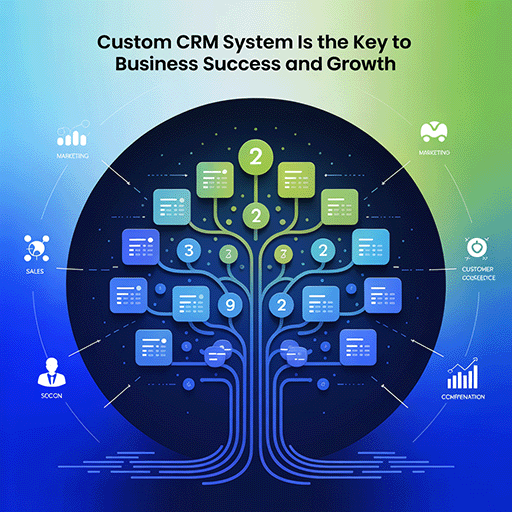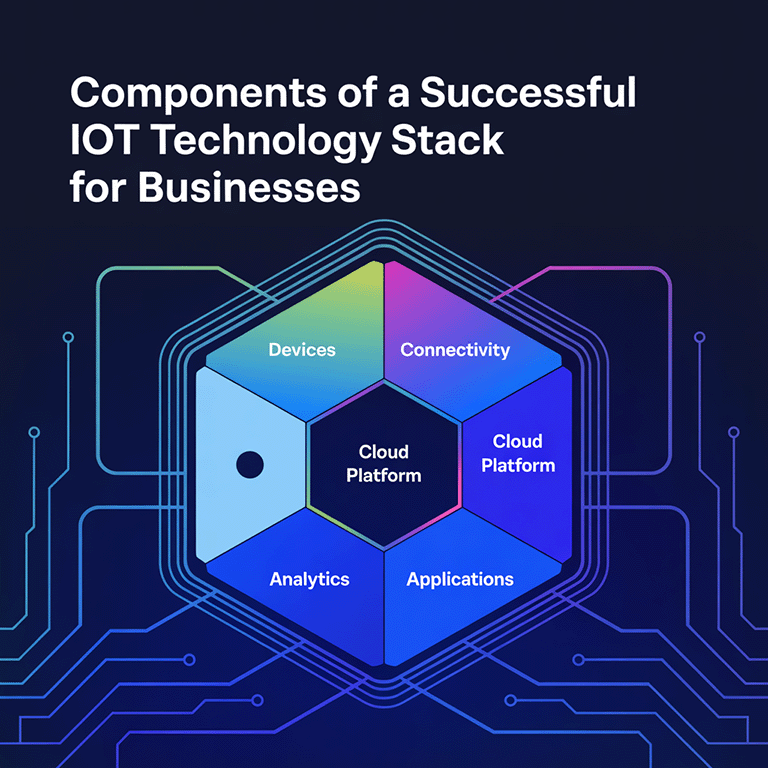It’s about the endless lines of cars inching forward, the honking horns, the frustrated drivers gripping their steering wheels. It’s about the hours wasted in congestion—100 hours a year for the average driver in a city like Los Angeles. It’s about the billions of dollars drained from the economy and the clouds of exhaust choking the air.
Imagine a world where red lights don’t make you wait longer than necessary. Where smart traffic management systems learn when traffic builds up and adjust routes in real time. Where AI helps you arrive at your destination faster, with less stress, and with fewer emissions polluting the planet.
This is not the future. It’s happening now.
Pittsburgh has cut travel times by 40% with AI-driven traffic signals. Google Maps uses AI to save drivers hours by avoiding congestion. The future of transportation is smart, efficient, and within reach.
This is an article about how AI is transforming traffic, and why your next drive could be the smoothest one yet.

Why Traffic Management Matters
Before diving into how AI can revolutionize traffic flow, let’s consider the very real challenges we face on our roads today. Traffic management isn’t just about easing the morning rush hour; it’s about creating a more efficient, sustainable, and livable transportation system for everyone.
At its core, effective traffic management orchestrates the symphony of vehicles traversing roads, ensuring a harmonious balance between supply and demand. When traffic flows smoothly, businesses thrive, commuters experience reduced travel times, and the economy benefits from heightened productivity. Conversely, gridlock and congestion inflict a heavy toll, draining resources, stifling economic growth, and exacerbating pollution levels.
Furthermore, managing traffic is crucial for protecting the environment. When cities reduce time spent idling and choose the best routes, they cut down on emissions, making urban areas cleaner and more sustainable. With climate change a pressing concern, cities need to adopt eco-friendly transportation solutions.
Beyond economic and environmental considerations, traffic management directly impacts public safety. Congested roadways not only breed frustration but also increase the likelihood of accidents and collisions. By leveraging AI-driven solutions to alleviate congestion and enhance traffic flow, cities can mitigate the risk of accidents, safeguarding the lives and well-being of their inhabitants.
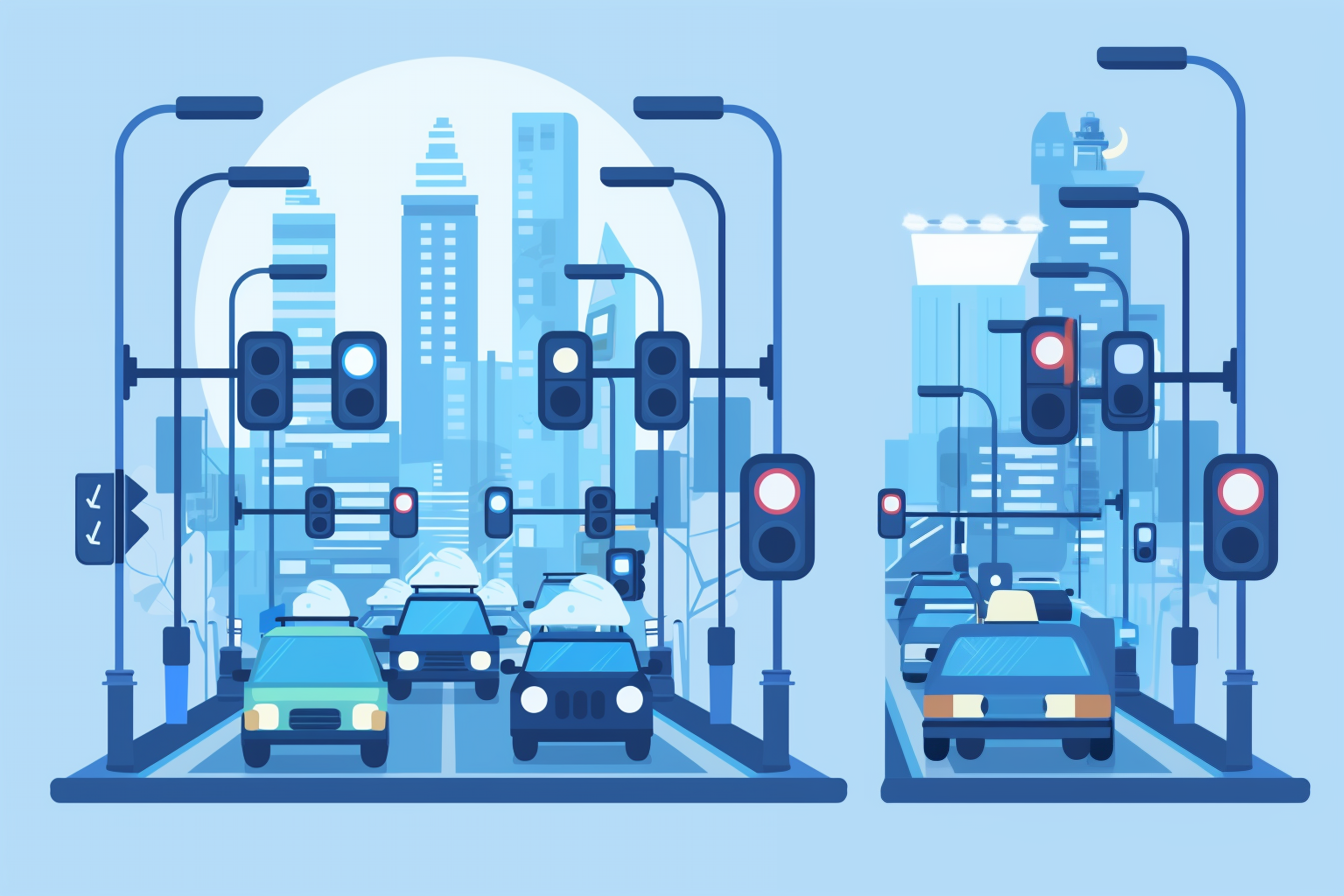
Real-World Applications and Success Stories
AI is, in reality, transforming cities and making them safer, faster, and greener in terms of transportation. Here are some of the most significant applications:
1. Adaptive Traffic Signals
We’ve already mentioned this case of AI in transportation but we’d like to give more details. AI-controlled traffic signals have hit Pittsburgh, Pennsylvania, and changed the operation of the city. These signals, developed at Carnegie Mellon University, change their timing in real-time based on the current traffic conditions. The results are impressive: a 40% increase in travel time and a 21% decrease in vehicle emissions.
The AI traffic management system collects information from cameras and radar sensors mounted at intersections. Different algorithms process this data to detect traffic trends and anticipate their transportation before accidents happen, thus changing timing dynamically to provide green lights more often to certain areas experiencing heavy traffic flows. This method will improve efficiency and drastically cut down on the nuisance of waiting at empty signals.
2. Predictive Navigation Systems
AI-enabled navigation tools such as Google Maps and Waze have already become synonymous with routing; however, their functionality extends much beyond that. Such apps analyze huge volumes of real-time data-source data such as GPS, various road closures, accident data, reports by users, and even analysis of predicted traffic conditions for optimal routing.
Take as an example Google Maps. This sole application uses AI to determine how long a specific route would take, depending on the present condition and historical data on traffic flow. Google Maps ward off more than 1.2 million metric tons of CO2e globally due to fuel-efficient routing. These systems are further learning and improving over time as they access user behavior and traffic trends and are becoming more and more effective with every trip.
3. Highway AI Traffic Management
Highways are infamous bottlenecks, but there is an AI-equipped to keep the traffic flowing. In Los Angeles, the city employs the Highways Regional Integrated Transportation Information System (IRITIS), which uses artificial intelligence to monitor highway traffic. By assessing the numerically driven cameras and sensors, RITIS will identify incidents such as collisions or stalled vehicles and give traffic operators alerts straight away. And that minimizes disruptions.
The Netherlands has an AI traffic system that anticipates traffic congestion on highways and alters speed restrictions by sending recommendations through digital markers. Recommended speeds will be shown according to real-time conditions in order to prevent possible accumulations from happening and even out the flow of vehicles.
4. Smart Parking Solutions
Finding parking in a jam-packed city would be a nightmare for those who drive around the city. Most importantly, it is considered one of the major causes of traffic congestion. Smart parking systems are now solving these problems with the help of AI. SFpark, for example, is a program in San Francisco that includes sensors to monitor real-time parking availability. It allows drivers to locate vacant spots using an app, saving them time wasted driving in circles.
According to the study, about 30% of search traffic may be eliminated from smart parking systems, which in turn will translate into lower emission levels and decreased driver stress.
5. AI-Powered Public Transit Optimization
The benefit of AI for public transport systems has not been left out. For instance, AI algorithms are employed in Singapore as tools to analyze the commuter data collected and create bus schedules and routes optimized thereof.
They are also useful in predicting peak travel times and high-demand areas with the buses being able to add routes based on these metrics and eventually help reduce overcrowding and waiting times.
Similar to this are the lines from Transport for London (TfL) that make use of the AI. They have incorporated AI with real-time monitoring and adaptation of traffic light timings in London. Service delays and other disruptions can easily be identified, and thus, enable buses to be rerouted together with real-time commuter updates making the whole system more reliable.
6. Incident Prediction and Prevention
In Japan, all weather data, along with various historical crash data and road conditions, have been fed into an AI system to predict accident surges in the country. When such an incident is predicted, relevant authorities institute measures such as increased patrols or temporary speed restrictions to reduce the incidents that occurred from their predictions.
7. Autonomous Vehicle Integration
Autonomous vehicles (AVs) are often seen as the future of transportation, but they’re already having an impact today. Companies, including Tesla and Waymo, have turned artificial intelligence into autonomous vehicles to be able to run independently in the most complicated traffic scenarios. Autonomous vehicles would communicate with intelligent infrastructures such as adaptive signals and connected roadways to make better and faster decisions.
In Phoenix, Arizona, Waymo’s self-driving taxis complete over 100,000 rides per week, making a strong case for how artificial intelligence is seamlessly merging with public transport.
8. Freight and Delivery Optimization
AI’s influence does not only end with improving personal commutes. It is changing logistics too. In logistics hubs such as Rotterdam, AI is used to optimize the movement of freight trucks and ensure that their delivery occurs on time without jamming the city streets.
The delivery giant UPS also uses an AI-controlled routing system to save fuel and time in deliveries. For instance, the application of the ORION routing system helped the company save approximately 10 million gallons of fuel each year by optimizing driver routes.
9. Air Traffic Management
Artificial intelligence is also a component of future transportation. In Europe, the SESAR project is on the use of AI, in managing air traffic, to predict flight delays and reroute planes to keep them away from congested airspace. This minimizes delays and increases safety in one of the busiest airspace areas.
AI-based Solutions for Traffic Optimization
The application of Artificial Intelligence in traffic optimization presents a vast array of innovative solutions aimed at addressing the multifaceted challenges inherent in urban mobility. AI-based systems offer a repertoire of tools and techniques to streamline traffic flow, alleviate congestion, and enhance overall efficiency. Here are some key AI-based solutions poised to transform traffic optimization:
1. Adaptive Traffic Control Systems (ATCS):
Function: ATCS utilizes AI algorithms and real-time traffic data to dynamically adjust traffic light timings. Cameras and sensors monitor traffic flow, and AI analyzes this data to optimize signal sequences, reducing congestion and wait times at intersections.
2. Intelligent Transportation Systems (ITS):
Function: ITS encompasses a broader range of AI-powered solutions for traffic management. These systems integrate data from various sources, including traffic cameras, connected vehicles, and weather sensors. AI algorithms can then analyze this data to:
- Predict traffic congestion: Identify potential bottlenecks and proactively adjust traffic flow.
- Issue real-time traffic advisories: Inform drivers of accidents, road closures, and alternative routes.
- Optimize public transportation: Analyze ridership data to optimize bus routes and schedules, improving efficiency and ridership.
3. Connected Vehicle Technology (CVT):
Function: CVT allows vehicles to communicate with each other and with roadside infrastructure. AI plays a crucial role in processing data from connected vehicles, such as:
- Speed and location data: This data can be used to create a real-time picture of traffic flow on a larger scale.
- Incident detection: Vehicles can share information about accidents or breakdowns, enabling faster response times.
- Cooperative Maneuvering: In this future, AI can utilize CVT data to enable vehicles to cooperate and optimize traffic flow even more effectively, potentially leading to platooning (vehicles traveling closely together) or automated lane changing.
4. Smart Parking Management Systems:
Function: Parking scarcity is a major contributor to traffic congestion. AI-powered parking management systems utilize sensors and cameras to detect available parking spaces in real time. Mobile apps can then provide drivers with information on available parking, reducing time spent searching and minimizing traffic caused by circling for spots.
5. Traffic Demand Management (TDM) Strategies:
Function: TDM strategies aim to influence travel behavior and reduce congestion. AI can be used to analyze traffic data and design dynamic pricing models for tolls and parking fees. These pricing models can incentivize carpooling, off-peak travel times, or utilizing alternative modes of transportation.
How to Implement AI into the Transportation Business
Integrating AI into transportation business operations takes time, joint effort, and resource allocation. It is not just a set of modern technologies but also includes its complete definition to be injected into the enterprise. The following is a stepwise guideline for implementing AI effectively.
1. Identify Business Challenges and Goals
Before jumping into AI, companies need to define the problems that they want to solve and the outcomes they want to achieve.
- Challenges: Is the goal to reduce delivery times, optimize fleet management, or improve customer experience?
- Metrics: Define measurable goals, such as cutting fuel consumption by 20% or reducing traffic congestion by 30%.
Example: A logistics company may focus on reducing delivery delays and improving route efficiency while a city transit authority may focus on minimizing wait times for buses.
2. Collect and Organize Data
AI heaps up on data so gathering relevant and exhaustive data is very crucial.
- Types of Data: GPS data, traffic flow statistics, weather reports, customer feedback, and historical performance records.
- Data Sources: Sensors, IoT devices, cameras, telematics systems, and external data providers.
- Data Infrastructure: Establish a centralized database or cloud-based solution to store and process data securely.
Example: Uber harnesses real-time GPS data from drivers, traffic conditions, and ride demand patterns to train AI algorithms in terms of surge pricing and route optimization.
3. Choose the Right AI Technologies
There are various AI technologies that can be tailored to different aspects of transportation:
- Machine Learning (ML): For predictive analytics, such as forecasting traffic congestion or delivery delays.
- Computer Vision: For autonomous vehicles, analyzing road conditions, and monitoring parking spaces.
- Natural Language Processing (NLP): For customer support chatbots or voice-activated navigation.
- Optimization Algorithms: For route planning, fleet management, and scheduling.
Example: DHL benefits from ML because it predicts the shipment volumes and optimizes warehouse allocation for last-mile delivery operations.
4. Collaborate with Experts
AI implementation often requires expertise beyond in-house capabilities.
- Hire AI Specialists: Data scientists, machine learning engineers, and AI consultants can guide the process.
- Partner with Tech Providers: Collaborate with AI solution providers, such as NVIDIA for autonomous driving or Microsoft Azure for cloud-based AI services.
- Train Staff: Upskill employees to work alongside AI systems, fostering a culture of innovation.
Example: The Port of Rotterdam partnered with IBM and developed an AI platform for logistics, which achieved an increase in efficiency at the port.
5. Pilot Programs and Testing
Start small with pilot programs to evaluate the feasibility and effectiveness of AI solutions.
- Define Scope: Implement AI in a specific area, such as a single delivery route or a few intersections.
- Monitor Performance: Measure results against key performance indicators (KPIs) to determine success.
- Iterate: Use feedback to refine AI models and address any challenges before scaling up.
Example: Pittsburgh tested AI-powered traffic signals at select intersections before expanding the system citywide.
6. Ensure Scalability
AI solutions should be scalable to accommodate growth and adapt to changing needs.
- Infrastructure: Invest in scalable cloud platforms to handle increasing data volumes.
- Interoperability: Ensure AI systems can integrate with existing software and hardware.
- Future-Proofing: Choose flexible technologies that can evolve with advancements in AI and transportation.
Example: FedEx implemented an AI-driven route optimization system that could scale to accommodate new delivery hubs and drivers.
7. Address Ethical and Regulatory Concerns
Artificial intelligence in transportation must comply with essential ethics and relevant laws.
- Data Privacy: Ensure preventive laws regarding user data and much cybersecurity involved have high privacy standards such as GDPR or equivalent in the area.
- Transparency: Ensure AI decisions, such as rerouting or pricing, are explainable and fair.
- Safety Standards: Test systems rigorously to guarantee safety, especially for autonomous vehicles.
Example: Waymo runs AI under testing for millions of miles on simulated environments before the AI meets safety regulations. Learn more about the ethical use of AI in our blog.
8. Monitor, Optimize, and Innovate
The implementation of AI does not finish with the deployment; the real work has only begun for long-term success.
- Performance Reviews: Regularly analyze KPIs to assess the AI system’s impact.
- Customer Feedback: Gather input from users to improve AI-driven services.
- Stay Updated: Keep pace with emerging AI technologies and incorporate them as needed.
Example: Tesla releases updates to its AI-based Autopilot software based on user driving behavior collected in real-time.
Benefits of AI in Transportation
In the pulsating heart of urban life, transportation is the lifeblood that keeps cities alive and thriving. But with the relentless rhythm of growth comes the challenge of managing the flow of people and vehicles.
Enter Artificial Intelligence, the game-changer in the transportation landscape. With its power to revolutionize everything from traffic management to public transit, AI promises a future where mobility is not just about movement but a dynamic, efficient, and exhilarating experience for all.
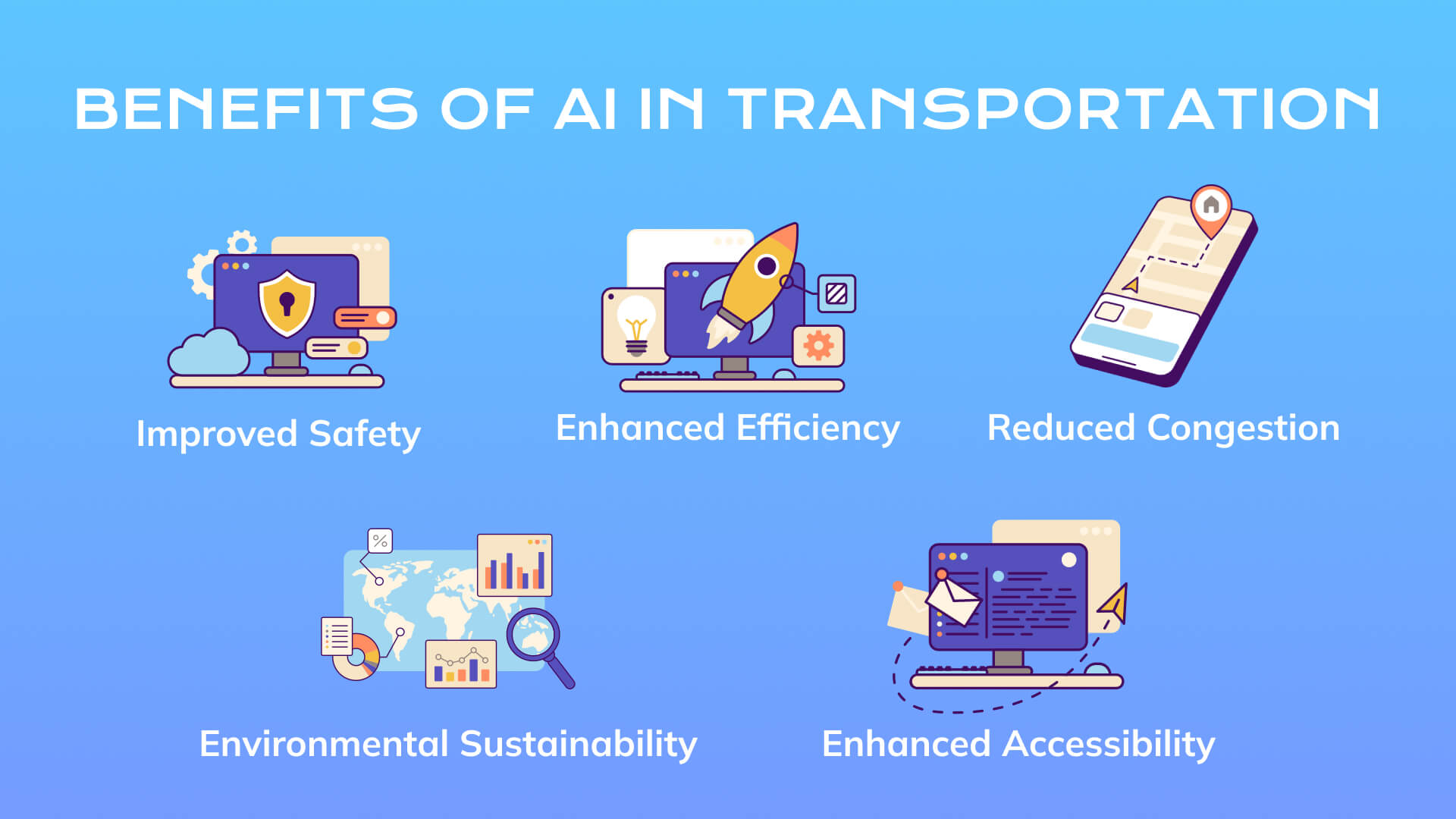
Improved Safety: AI-powered systems enhance safety across all modes of transportation by detecting and mitigating potential risks in real time. Advanced driver assistance systems (ADAS) equipped with AI algorithms can identify hazards such as pedestrians, cyclists, and other vehicles, issuing alerts or initiating autonomous emergency braking to prevent collisions. Similarly, AI-enabled traffic management systems optimize signal timings, lane assignments, and intersection configurations to minimize the risk of accidents and improve overall road safety.
For example, Mobileye has pursued a singular mission: to enhance road safety through cutting-edge technology. Initially, a small team led by Professor Amnon Shashua sought to transform the driver-assist field using just a single camera and a system-on-a-chip. Today, around 170 million EyeQ™ chips are deployed globally. This is the contribution of only one company to road safety; we can imagine the scale of the global development of road safety.
Enhanced Efficiency: AI streamlines transportation operations and optimizes resource allocation, leading to more efficient use of infrastructure and reduced travel times. Dynamic routing algorithms analyze real-time traffic data to identify the fastest and most efficient travel routes, minimizing congestion and optimizing travel times for drivers, public transit passengers, and freight carriers alike. Additionally, AI-driven predictive maintenance systems monitor the health of vehicles and infrastructure assets, identifying potential failures before they occur and minimizing downtime for repairs.
Reduced Congestion: AI-based traffic management systems alleviate congestion and improve traffic flow by dynamically adjusting signal timings, lane configurations, and intersection operations in response to changing traffic conditions. By optimizing the use of available roadway capacity and redistributing traffic across alternative routes, these systems minimize bottlenecks and reduce delays, resulting in smoother and more predictable travel experiences for commuters and travelers.
Environmental Sustainability: AI-driven transportation solutions promote sustainability by reducing greenhouse gas emissions and mitigating environmental impact. Dynamic routing algorithms optimize travel routes to minimize fuel consumption and emissions, while AI in transportation optimizes vehicle performance and efficiency, reducing fuel consumption and emissions associated with mechanical failures and inefficiencies.
AI-enabled traffic management systems prioritize alternative modes of transportation, such as public transit, cycling, and walking, reducing reliance on single-occupancy vehicles and promoting eco-friendly transportation options.
Enhanced Accessibility: AI improves accessibility for individuals with mobility challenges by providing personalized, real-time travel assistance and support. AI-powered navigation apps and mobility platforms offer tailored route recommendations and transportation options based on individual preferences and accessibility needs, enabling individuals with disabilities to navigate urban environments more independently and efficiently.
Considerations and Challenges on the Road to AI-powered Transportation
While AI offers a bright future for transportation, it’s crucial to acknowledge the considerations and challenges that must be addressed for its successful and responsible implementation. Here’s a deeper dive into some key areas that require careful consideration:
1. Ethical Concerns and Algorithmic Bias
AI algorithms are only as good as the data they’re trained on. If data used to train AI systems for traffic management is biased, it can lead to unintended consequences. For example, an AI system might prioritize traffic flow for cars over pedestrian safety if the training data doesn’t adequately account for pedestrian movement. It’s crucial to ensure that AI algorithms are developed and implemented in a fair and ethical manner, considering the needs of all users of the transportation system.
2. Data Privacy and Security
AI in transportation relies heavily on data collected from various sources, including connected vehicles, traffic cameras, and even mobile apps. This raises concerns about data privacy and security. Robust data security measures need to be in place to protect sensitive user information and prevent unauthorized access. Additionally, clear regulations regarding data ownership and usage are essential to ensure public trust in AI-powered transportation systems.
3. Infrastructure Investment and Technological Parity
The full potential of AI in traffic management can only be realized with adequate investment in supporting infrastructure. This includes upgrading traffic control systems, deploying connected vehicle technology, and ensuring widespread internet connectivity. Furthermore, the benefits of AI shouldn’t be limited to those with access to the latest technology. Solutions should be designed to be inclusive and accessible to users of all demographics and socioeconomic backgrounds.
4. Cybersecurity Threats and System Vulnerability
AI-powered transportation systems are complex and interconnected, making them potential targets for cyberattacks. Robust cybersecurity measures need to be implemented to protect these systems from disruptions or manipulation. Additionally, contingency plans need to be in place in case of system failures to ensure the continued smooth operation of the transportation network.
5. The Human Factor: Transition and Workforce Impact
AI promises to automate many aspects of traffic management, raising concerns about job displacement in the transportation sector. Strategies for workforce transition and reskilling must be developed to ensure that technological advancements include workers. Furthermore, it’s important to remember that AI is a tool, not a replacement for human judgment and expertise. Human oversight and control will remain crucial in ensuring AI-powered transportation systems’ safe and responsible operation.
The Future of AI in Transportation
Looking ahead, the future of AI in transportation holds boundless potential for innovation and transformation. As AI technologies continue to evolve and mature, we can expect to see a proliferation of smart, interconnected transportation systems that redefine how we move and interact with our urban environments. Here are some key trends and developments shaping the future of AI in transportation:
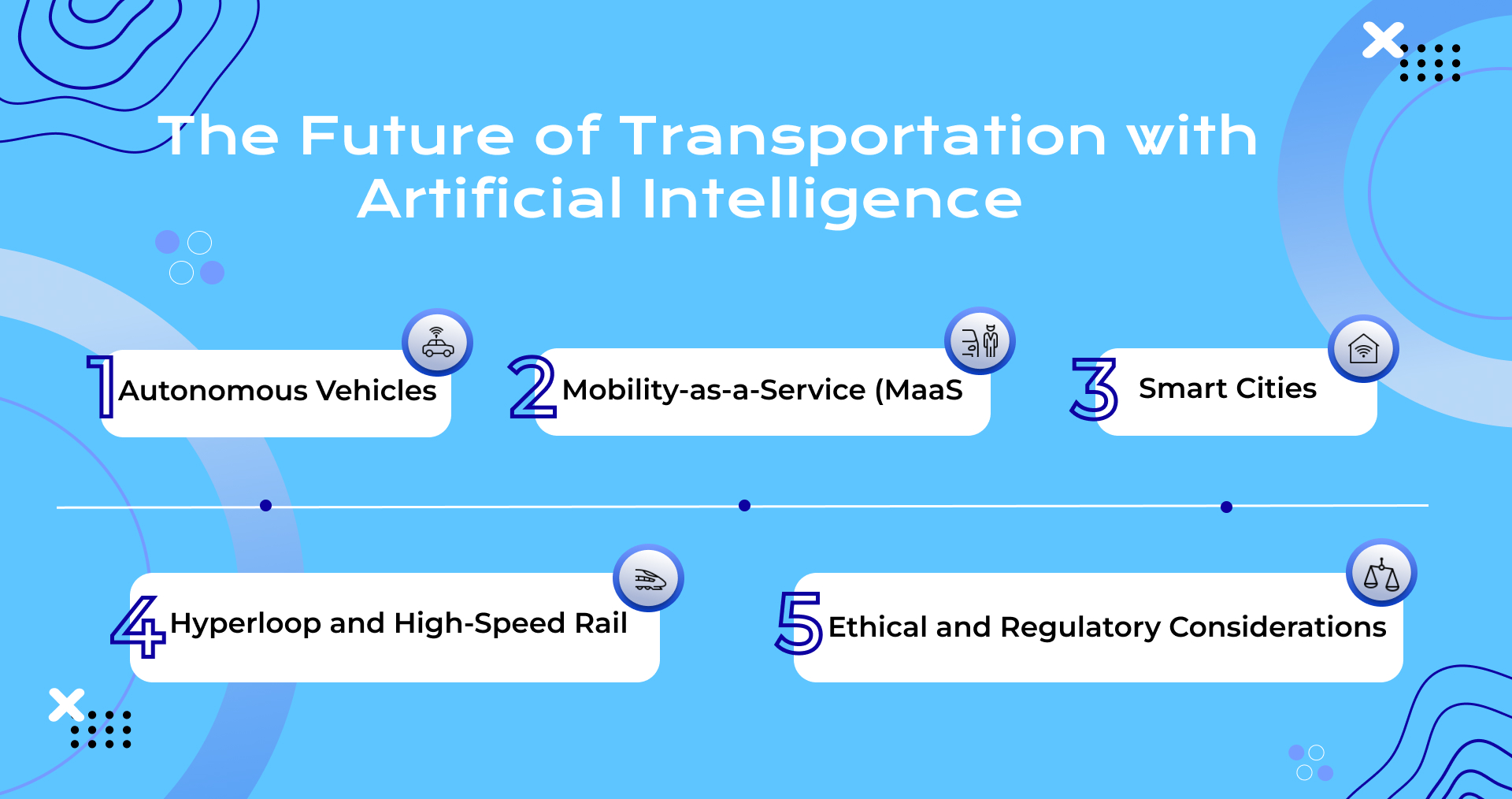
- Autonomous Vehicles: The widespread adoption of autonomous vehicles (AVs) represents a paradigm shift in transportation, ushering in an era of safer, more efficient, and convenient mobility. AI-powered self-driving cars, trucks, and buses promise to revolutionize personal and freight transportation, reducing accidents, congestion, and emissions while enhancing accessibility and convenience for passengers.
- Mobility-as-a-Service (MaaS): AI-enabled mobility-as-a-service platforms are poised to transform the way people access and use transportation services. By integrating various modes of transportation, including ride-hailing, public transit, bike-sharing, and micro-mobility options, MaaS platforms offer seamless, on-demand mobility solutions tailored to individual preferences and needs. These solutions reduce reliance on personal vehicles and promote sustainable urban mobility.
- Smart Cities: AI serves as the cornerstone of smart city initiatives aimed at creating more livable, sustainable, and resilient urban environments. AI-powered traffic management systems, intelligent transportation networks, and predictive analytics tools enable cities to optimize resource allocation, reduce congestion, and enhance public safety, fostering vibrant and inclusive communities where people can live, work, and play with greater ease and efficiency.
- Hyperloop and High-Speed Rail: AI plays a pivotal role in the development of next-generation transportation technologies such as hyperloop and high-speed rail systems. By leveraging AI for route optimization, predictive maintenance, and passenger safety, these innovative transportation solutions offer the promise of ultra-fast, energy-efficient travel over long distances, connecting cities and regions in ways previously thought impossible.
- Ethical and Regulatory Considerations: As AI becomes increasingly embedded in transportation systems, it raises important ethical and regulatory considerations related to safety, privacy, equity, and employment. Addressing these challenges will require collaboration between policymakers, industry stakeholders, and the public to ensure that AI-driven transportation innovations benefit society as a whole while minimizing potential risks and unintended consequences.
AI in Transportation and the Smart City
By 2050, it’s estimated that 68% of the world’s population will live in urban areas. AI-powered smart city transportation systems will be crucial for managing traffic flow, optimizing public transportation, and creating a more sustainable and livable urban future.
The use of AI in transportation is essential for making city travel more efficient, sustainable, and safe. It uses artificial intelligence to improve various parts of transportation, like managing traffic and public transit.
Picture a city where traffic moves smoothly, adjusting instantly to reduce jams and shorten travel times. AI-powered traffic systems make this happen by analyzing lots of data from sensors, cameras, and GPS devices to predict traffic patterns, find problem areas, and adjust traffic signals.
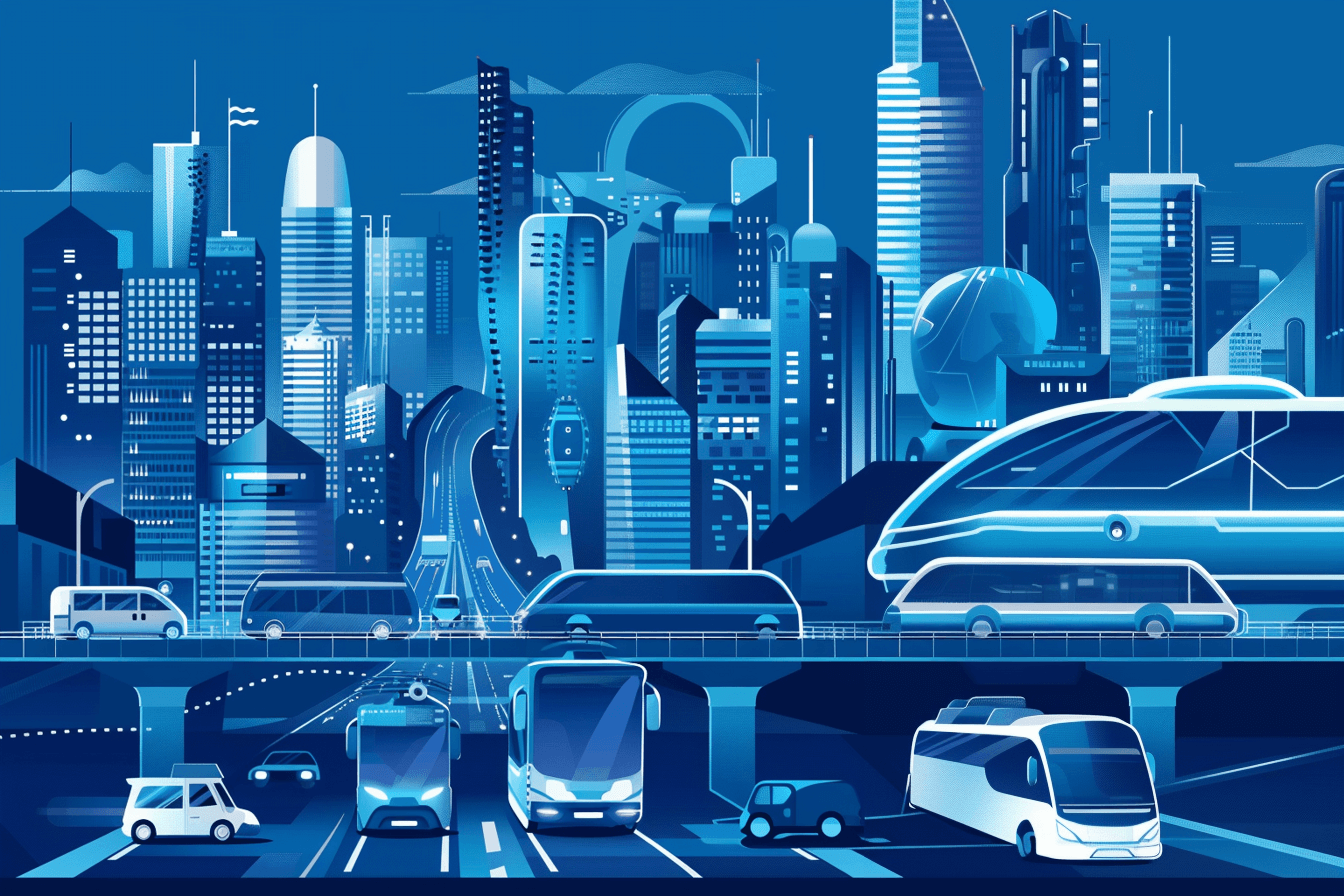
AI also improves public transit by giving commuters personalized route suggestions, real-time updates on arrivals, and smarter schedules. These systems learn from feedback and data to improve over time.
Besides making daily commutes easier, AI helps cities meet sustainability goals by promoting electric and self-driving cars. AI-powered charging stations predict when they’ll be needed most and manage charging times, reducing emissions and improving safety for self-driving cars.
AI also helps prevent transportation breakdowns by spotting problems before they happen and scheduling maintenance to keep things running smoothly.
And AI isn’t just for cities—it helps connect different transportation methods for smoother journeys, whether you’re traveling within the city or between cities and modes of transportation.
Overall, AI in transportation is vital for creating smarter cities and making travel more efficient, greener, and safer.
Final Note
With AI as the conductor, our cities are poised to transform into a meticulously orchestrated ballet of movement – efficient, sustainable, and designed for the well-being of all citizens. While challenges remain, the potential of AI to revolutionize transportation is undeniable.
So, buckle up, adjust your mirrors, and get ready for a ride unlike any other. The future of transportation, powered by AI, is about to take center stage, and it promises to be a harmonious performance for all.
Are you looking to be at the forefront of the AI transportation revolution? LITSLINK, a leading software development company with a proven track record in AI solutions, is the perfect partner for you.
We combine our expertise in artificial intelligence with a deep understanding of the transportation sector to create groundbreaking solutions. Let’s collaborate and push the boundaries of transportation together!


